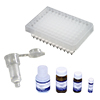Capillary Tubing
Fused Silica Capillary Tubing (Deactivation)
Retention Gap
A retention gap column prevents GC analyses from broad peak band or multiple peaks of 1 compound. In GC analysis, when using On-Column or Splitless method, sometimes peak band broads or one peak separate into multi-peak. This is mainly experienced when the sample injection volume exceeds 1 μL or when a sample of polar solvent is analyzed on a nonpolar column. The pervious cause is when a large amount of sample injected into a column, the sample is pushed into the column deeply into the column while forming a thin film on the liquid phase surface, resulting in peak band broadening. In next case, solvent flows through the column as several partitioned drops, which may result in the resolution of the solute peak. The silica capillary tube is well suited to most solvents other than water by internal surface treatment and has no holding power against solutes. The silica capillary tube can be used as a retention gap by connecting the silica capillary tube to the entrance of the separation column for about 2 m. Liquid sample injected evenly spreads in a silica capillary tube and begins to vaporize and move sequentially from low-boiling objects with increasing oven temperature. At this time, the retention gap is not holding, so solutes rapidly reach the separation column entrance, where they are concentrated by the holding force of the liquid phase. Therefore, the on Column and Splitless method can be performed without compromising the high-separation characteristics of silica-capillary columns.
Guard Columns
Injecting samples with contamination or nonvolatile compounds directly to column causes active spots or degeneration of the column. To protect a column from such damages, it is effective to connect a 2 m fused silica capillary tube to inlet of the analytical column and replace them as the contamination gets accumulated.
Transfer line
A transfer line is able to be used for GC/MS, LC/MS, GC/FTIR, LC/GC, Multi‐Dimensional GC or sniffer adaptors.
Deactivated fused silica capillary tubing
As fused silica is relatively inert structure, in general usage there are no analytical problem. However, sometimes tailing or adsorption occur when analyzing polar sample, by the influence of Siloxane Bridge and silanol remain in the inner of column. GL Sciences offer our original inertness technology of deactivated fused silica capillary tubing, it shows strong inertness to polar samples.




























